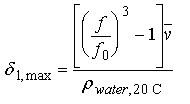Calculating Maximum Hydration
Water of hydration is considered to be water that differs from the bulk phase due to its interaction with the protein. Our knowledge of the degree of hydration for proteins is poor, largely because the values for δ1 determined are dependent on the techniques used (Ref. 28 29 30 31 32 33 39 40 41 42 43 51 52 53 54). The problem is that different methods will report different amounts of water "under the influence" of the protein because the methods are intrinsically sensitive to dissimilar properties of the water. Most methods distinguish two different realms of hydration water, that directly interacting with the protein (primary hydration shell) and that merely "influenced" by being in contact with the primary shell (secondary hydration) (Ref. 52). It is not clear whether one, both or some combination of these two shells corresponds to the hydration that influences sedimentation behavior. This ambiguity complicates the estimation of the asymmetry due to the common effects hydration and shape have on hydrodynamics (Ref. 28 29). If one assumes that the protein is spherical, then the maximum degree of hydration can be calculated. Alternatively, one can estimate δ1.
Calculation of maximum hydration: The predicted maximum degree of hydration (g-H2O per g-protein) can be calculated in different ways depending on whether equation 21 or 22 is used to estimate the radius needed for f0 (equation 23) and depending on how the protein volume is calculated. If one follows the more "traditional" pathway of calculating Ro using equation 21, then the maximum hydration is calculated with equation 25:
Equation 25:
where f is the frictional coefficient calculated from s20w and Mr (see equation 3), f0 is the minimum frictional coefficient from equation 23, and vbar is the partial specific volume of the solute. On the other hand δ1,max, can be calculated from the empirical equations of Teller (Ref. 33) by substituting Rp for R0 in computing f0 and substituting vp=0.7654 ml/g (from equation 7 of reference 33) for vbar.
Sednterp performs both variations of this calculation automatically in the Results form when the necessary information has been entered (unless the user has chosen to calculate or enter an estimate of hydration in order to compute a more accurate a/b ratio).
